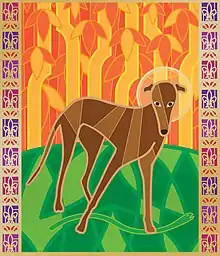Saint Guinefort
Saint Guinefort (French pronunciation: [ɡin.fɔʁ]) was a 13th-century French dog that received local veneration as a folk saint after miracles were reported at his grave.[1][2]
Saint Guinefort | |
|---|---|
 Modern illustration of St. Guinefort | |
| Dog Saint | |
| Died | 13th-century near Lyon, France |
| Venerated in | Folk Catholicism |
| Feast | Venerated locally on August 22 |
| Patronage | Infants |
Catholic cult suppressed | Never recognized officially by Catholic Church; cult persisted until the 1930s by Catholic Church |
Legend
His story is a variation on the well-travelled "faithful hound" motif, similar to the Welsh story of the dog Gelert. Guinefort the greyhound belonged to a knight who lived in a castle near Lyon. One day, the knight went hunting, leaving his infant son in the care of Guinefort. When he returned, he found the nursery in chaos – the cot was overturned, the child was nowhere to be seen and Guinefort greeted his master with bloody jaws. Believing Guinefort to have devoured his son, the knight slew the dog. He then heard a child crying; he turned over the cot and found his son lying there, safe and sound, along with the body of a viper. Guinefort had killed the snake and saved the child. On realizing the mistake the family dropped the dog down a well, covered it with stones and planted trees around it, setting up a shrine for Guinefort. Guinefort became recognised by locals as a saint for the protection of infants. It was alleged by contemporary commentators that locals left their babies at the site to be healed by the dog:
- The local peasants hearing of the dog's noble deed and innocent death, began to visit the place and honor the dog as a martyr in quest of help for their sicknesses and other needs.
- Stephen of Bourbon (d. 1262): De Supersticione: On St. Guinefort.[1][2]
The cult of this dog saint persisted for several centuries, until the 1930s, despite the repeated prohibitions of the Catholic Church.[2]
In popular culture
The 1987 French film Le Moine et la sorcière (in the US known as The Sorceress) depicts the controversy over St. Guinefort as seen through the eyes of Fr. Etienne de Bourbon, a Dominican inquisitor and the author of the above passage.
Thomas of Hookton, the main character in Bernard Cornwell's The Grail Quest trilogy (2000–2003), was a mock believer in Saint Guinefort, praying to the saint and wearing a paw on a piece of leather around his neck.
In Adam Gidwitz's 2017 young adult novel The Inquisitor's Tale, the main characters' pet greyhound Gwenforte bears a strong resemblance to Saint Guinefort, especially in the manner of his death and resurrection early in the novel.
See also
- Saint Christopher - a saint often portrayed with the head of a dog
- The Brahmin and the Mongoose
Notes
- Halsall, Paul (September 8, 2000). "Stephen de Bourbon (d. 1262): De Supersticione: On St. Guinefort Etienne de Bourbon". Medieval Sourcebook. Fordham University. Retrieved October 5, 2013.
- Dickey, Colin (June 18, 2013). "A Faithful Hound". Lapham's Quarterly. Retrieved September 4, 2016.
External links
- Holy Dogs and Dog-Headed Saints
- The Greyhound Saint
- Halsall, Paul (September 8, 2000). "Stephen de Bourbon (d. 1262): De Supersticione: On St. GuinefortEtienne de Bourbon". Medieval Sourcebook. Fordham University. Retrieved October 5, 2013. (the source text for the story)
- Tuder de Courtecadeno, Mevanwy verch, a/k/a Mark S. Harris (May 2005). "Guinefort: The Sainted Dog of France". The Barge. Stefan's Florilegium. Retrieved October 5, 2013.